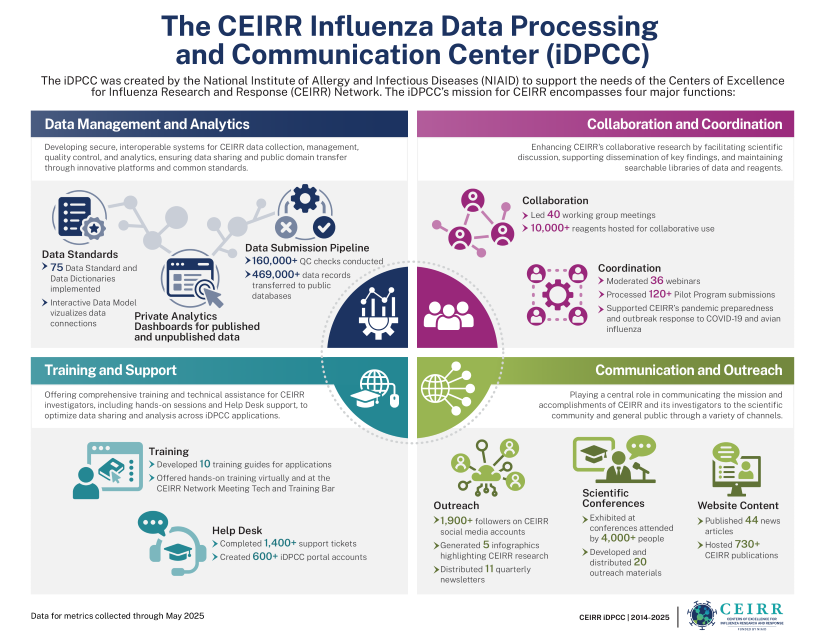
Composed of seven multidisciplinary and collaborative Centers, the CEIRR Network studies the natural history, transmission, and pathogenesis of influenza, and provides an international research infrastructure to address outbreaks of influenza and other emerging respiratory viruses. Six Centers focus on key influenza research areas, while the Influenza Data Processing and Communication Center (iDPCC) supports the entire Network through:
- Data Management and Analytics
- Collaboration and Coordination
- Training and Support
- Communication and Outreach
Under the leadership of Dr. Stephan Bour, Ph.D., the iDPCC brings together four collaborating organizations, led by prime contractor Digital Infuzion, to deliver seamless support across the CEIRR Centers. This unified structure ensures each Center receives the data coordination services needed to achieve its research goals.
However, the iDPCC wasn’t always part of the program. In the original CEIRS initiative (2007–2014), data sharing was a decentralized effort left to individual investigators. “This decentralized approach led to inefficiencies and bottlenecks that limited public data sharing,” recalls Dr. Bour. Recognizing the need for a more centralized solution, the Data Processing and Coordinating Center (DPCC) was established in the second CEIRS cycle (2014–2021), laying the foundation for what has now evolved into today’s iDPCC within CEIRR.

Dr. Bour explains that the iDPCC sits “at the intersection of geographically distributed research Centers” and aims to “facilitate data and information dissemination across the Network and the broader scientific community”. The center also provides “a technical platform for data sharing and communication initiatives that encourages cross-Center collaborations.” The iDPCC team has developed over 75 data standard templates to ensure data compatibility across the Network, which can be analyzed in private dashboards before being transferred to public databases upon publication. Since inception of CEIRR, the iDPCC has facilitated the dissemination of nearly half a million individual data records to public databases like the BV-BRC, ImmPort, and GenBank. With collaboration as a central tenant of the program, the iDPCC facilitates knowledge sharing through hosting working group meetings and webinars. When CEIRR investigators and staff need assistance, the iDPCC steps up by responding to Help Desk support tickets and developing training guides for network-specific online tools. The iDPCC team also helps promote the mission and accomplishments of CEIRR through outreach at conferences, posting on social media, and publishing articles and infographics on the CEIRR public website.
The iDPCC team continues to evolve and adapt to changing technology, a strength that particularly energizes Dr. Bour: “The most exciting opportunity we’ve discovered is how generative AI can enhance our ability to communicate better, process data faster, and discover novel insights from the data we manage.” When asked about the future of the CEIRR program, Dr. Bour reflected on the remarkable success and productivity of the program’s almost 20-year existence. He noted that CEIRR has “demonstrated its ability to pivot quickly to address emerging infectious disease threats,” which he hopes to see continue in the current program and any future iteration. Dr. Bour ended by adding, “I would love to see an expansion of the surveillance mission while bringing technology to enhance the efficiency of the activities,” highlighting animal and human surveillance as a unique strength of CEIRR.
The iDPCC interviewed Dr. Bour to learn more about his experiences:
1. How has your career trajectory changed over time?
A. My career has significantly changed since I was a Staff Scientist at NIAID. I discovered bioinformatics in the late 1990s during the first human genome sequencing project and never looked back. I then went into computer science with both feet, became a CIO, and finally landed at a biomedical research-focused technology company.
2. What technique, skill, or knowledge are you the “go to” person for in your field?
A. Data science and data management.
3. What is your favorite country to attend a conference… or a vacation?
A. France. Always an opportunity to visit family and old friends.
4. Are you a morning person or a night person?
A. Definitely not a morning person!